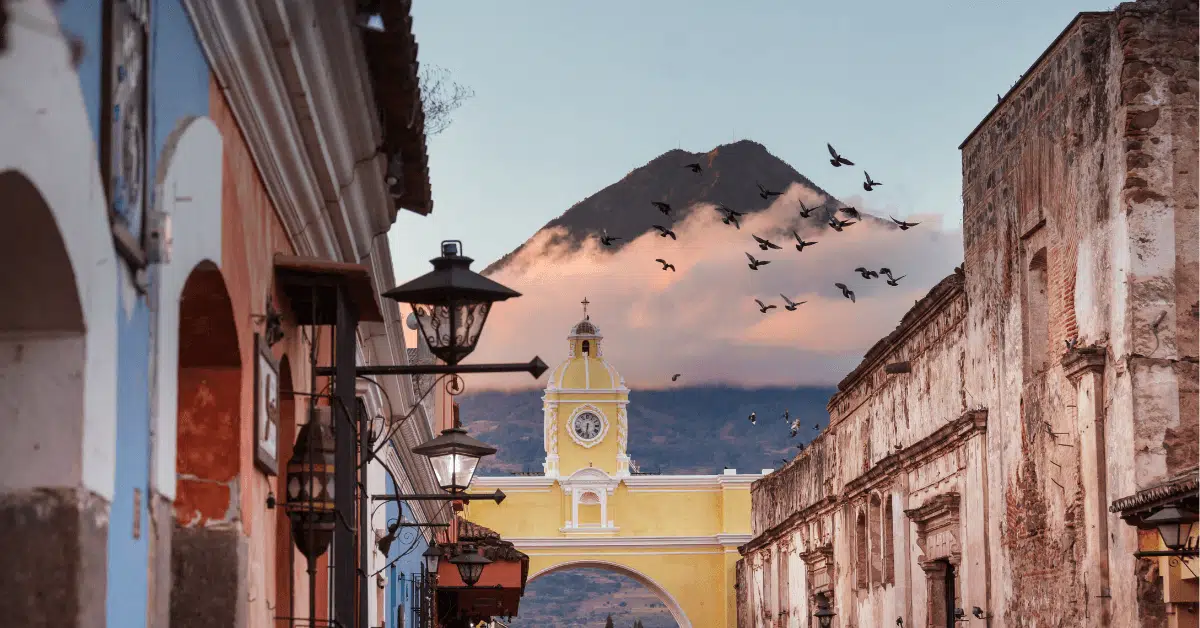14 Best Cities for Digital Nomads in Latin America
The digital nomad lifestyle has taken off faster than ever expected, and it doesn’t show signs of slowing down any time soon. While there are only estimated to be around 35 million full-time digital nomads around the world, hundreds of millions more are taking advantage of new remote work and flexible work arrangements to marry travel and work unlike ever before.
For those looking to get a start as a digital nomad – especially those that have to work in the same time zone as Canada or the United States – Latin America is both an affordable and convenient option. While Latin America has countless offerings for digital nomads when it comes to lifestyle, affordability, and travel, these are some of the top and up-and-coming cities for digital nomads in Latin America.
Best Latin America Digital Nomad Destinations
Anyone who has ever traveled through Latin America will tell you how wildly different each country is, even each region is, from other places in Latin America. Please don’t expect all tacos and guacamole here – it sounds horrible, but this is unfortunately what many travelers are expecting.
Check out our map of the best digital nomad cities in Latin America to get a better idea of the places we recommend.
From Caribbean island cities to massive metropolises with all four seasons, you will find a huge range of spots that are home to digital nomads in Latin America. Beach towns, major cities, ultra-modern skyscrapers, and tiny jungle villages all coexist, often within just a few hours of each other.
Looking for the best digital nomad cities around the world? We have an article about that, too!

Cities for Digital Nomads in Latin America
1. Buenos Aires, Argentina
Buenos Aires is my personal dream digital nomad hub in Latin America – and the large number of digital nomads that flock to the city must agree.
I lived in Buenos Aires for about six months and have been back several times since – to say I loved my time there is an understatement. It is a bustling city that seems like a combination of New York, Paris, and Latin American flare combined in an indescribable way.
As a major cosmopolitan city, you’ll meet plenty of people from every part of the world, and representing every industry, and it is quite easy to make friends and socialize. There is also a large number of coworking spaces – check out Urban Station or La Huerta. There is also a huge café culture, more than I’ve experienced in other Latin American cities, which makes it perfect for switching up your work spot from day to day.
I would recommend Buenos Aires to those who are considering digital nomad Latin America life but perhaps haven’t traveled much in Latin America before: the city has a European feel and is distinct from other large cities in the region.
Read More: Ultimate Digital Nomad Guide to Buenos Aires
Pros of Buenos Aires, Argentina
- You’ll love the big city living in Buenos Aires. There are countless things to do in Buenos Aires, and everything you could want or need is right at your fingertips.
- Buenos Aires has fast and widely-available internet. Whether you’re at a coworking space or at home, you’ll have no issue connecting here.
- The high inflation in the Argentine Peso – while obviously not a positive for locals – means that foreigners are able to live comfortably at a very low cost in Buenos Aires. You’ll be shocked at how far your money gets you here.
- There are a lot of travel destinations near Buenos Aires, including the region home to Malbec wine in Mendoza, Argentina, and just a short ferry ride across the river are Uruguay’s famed beaches, some of the most beautiful in South America.
Cons of Buenos Aires, Argentina
- Buenos Aires is surprisingly quite far from even other South American capitals – Rio de Janeiro is a 3-hour flight, and Santiago, Chile is 2.5 hours – not to mention the States or Europe. Flights to Miami are 9.5 hours!
- Don’t expect tropical weather here! It gets quite cold in Buenos Aires in the winter (which is June-August as it is in the Southern Hemisphere).
- Argentina’s very meat-heavy diet makes it more challenging for vegetarians to navigate, though Buenos Aires does have its fair share of vegetarian spots. The rest of Argentina can be more challenging for veggie-based eating.
Cost of Living: $500-1000 per month
Plan a Trip to Argentina
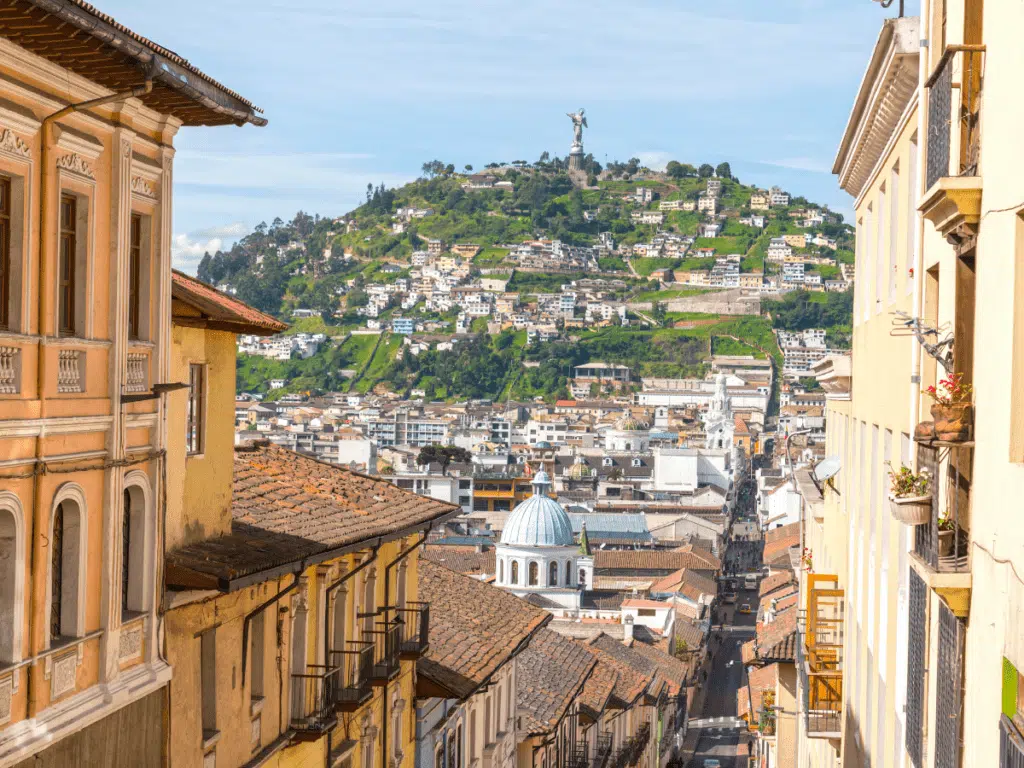
2. Quito, Ecuador
I called Quito, Ecuador home for two years, so I definitely feel I have a lot to share about living in Ecuador. Quito is an incredible, breathtaking city with so much to offer – even after two years there, I can’t wait to get back.
Ecuador is an up-and-coming place for digital nomads, but as a major city Quito offers the amenities that digital nomads are looking for, including a slew of trendy new cafes and a growing number of co-working spaces like Impaqto. You’ll find everything you need and more in Quito.
Ecuador is an incredibly compact country, making travel to the beach, in the Andes mountains, or the Amazon rainforest possible for a weekend trip. The travel opportunities are endless, and after traveling throughout Latin America extensively, I can say mainland Ecuador (often passed over by travelers on the way to the Galapagos) is one of Latin America’s gems.
Ecuador also boasts a new digital nomad visa that allows remote workers who make just a little money to stay for up to two years! Don’t sleep on Ecuador, and especially the lively city of Quito. This is poised to be Latin America’s next digital nomad hotspot.
Read More: Ultimate Digital Nomad Guide to Living in Ecuador
Pros of Quito, Ecuador
- The cost of living in Quito can easily be kept quite low, even below $1,000 if you budget carefully. Choose more residential areas to live in, eat local food, and use public transport and you’ll have a lovely experience for just a little money.
- Quito boasts all the big city amenities you could want. A well-connected international airport, modern malls and shopping centers, great cafes and restaurants, coworking spaces, and unending things to do make this a great place to live.
- Ecuador has so many incredible travel opportunities, from Baños and Mindo to the stunning Ecuadorian coast, Galapagos Islands, and the Amazon Rainforest. You could spend years exploring and not see it all (I know, I tried).
- Quito has a moderate but quickly growing number of long-term transplants and digital nomads. Ecuador’s new digital nomad visa promises to bring even more, while making life a lot easier for those already here.
Cons of Quito, Ecuador
- Imported goods in Ecuador can be expensive, such as any tech products or brands of food or toiletries from home. Bring any of these things with you, if you can.
- Quito is not very walkable and it will take some time to adjust to public transport, though buses and trolleys are affordable and plentiful.
- Quito is a relatively safe city, though you’ll need to be careful of pickpocketing. Don’t flash expensive items like technology when out and about. Keep an eye on your belongings and be street-smart! This is more than enough to keep you safe.
Cost of Living: $900-1900 per month
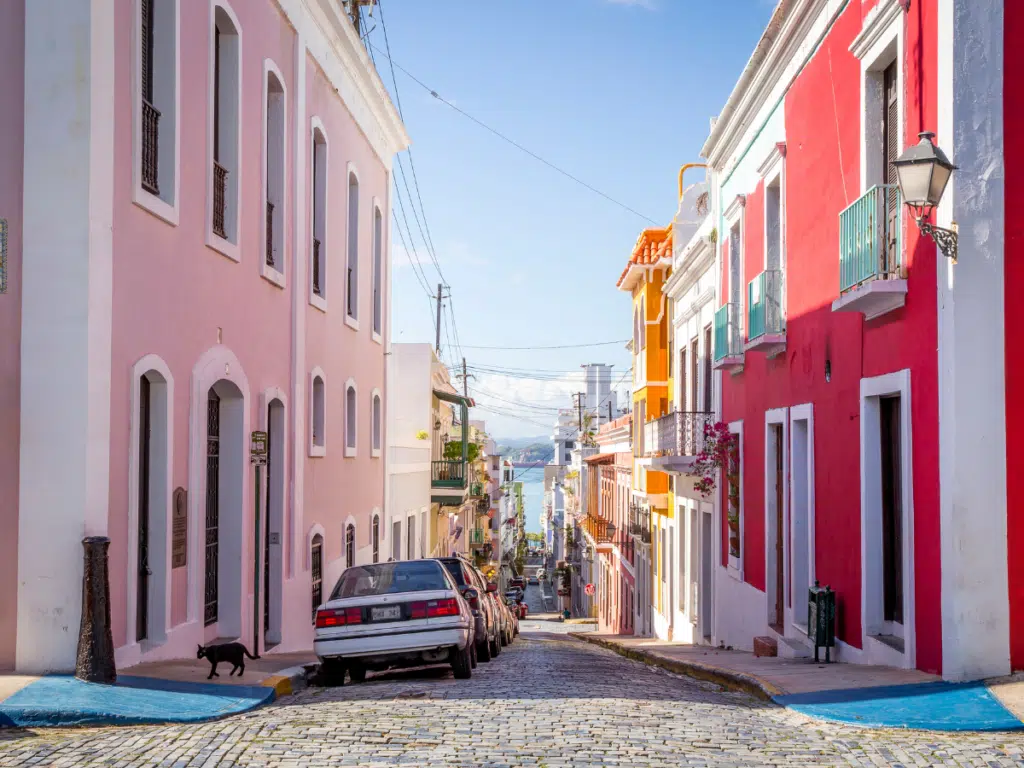
3. San Juan, Puerto Rico
Looking for an ultimately easy destination as a U.S. digital nomad? There is no easier (or dreamier!) location than San Juan, Puerto Rico. No need to worry about visas, complex tax situations that arise from spending long periods of time in other countries, or any of the other hassles digital nomads often face. Heck – you don’t even need a passport!
The conveniences of spending time in Puerto Rico as a digital nomad make it one of the easiest destinations in Latin America for digital nomads. In fact, if you’re considering getting started as a digital nomad, this might be the perfect place to start. Get your feet wet here before navigating other countries. Of course, this is only true for U.S. citizens and residents.
Digital nomads in Puerto Rico enjoy incredible weather almost year-round, vibrant culture, a growing digital nomad and expat community, and an enviable Caribbean location with plentiful flight access to nearby islands and countries.
Read More: 20 Best Things To Do in Puerto Rico
Pros of San Juan, Puerto Rico
- You’ll enjoy all the conveniences of home in San Juan. If you’re from the United States, that means no additional phone bill to pay or SIM card to buy, no need to deal with visas, and no worries about exchange rates and fees.
- While Spanish is the majority language in Puerto Rico, English is widely spoken. Don’t expect English to be spoken everywhere, but it certainly makes it easier to navigate Puerto Rico if you don’t speak English.
- Puerto Rico is, well, pretty beautiful. From some of the best beaches in the Caribbean to stunning tropical rainforest, this island is a pretty dreamy place to call home for a few weeks, months, or even years.
Cons of San Juan, Puerto Rico
- While there are ways to live on a budget here, San Juan can be quite an expensive destination for digital nomads. Expect to pay more than you would in most other digital nomad Latin America destinations.
- It is not easy for travelers from many other countries to spend an extended stay in Puerto Rico. As a territory of the United States, Puerto Rico has all the same immigration laws as the mainland – that means no digital nomad visa, and extremely rigid, often impossible visa and residency requirements. Consider elsewhere if you’re not a United States resident or citizen already.
Cost of Living: $2,500 – 3,200 per month
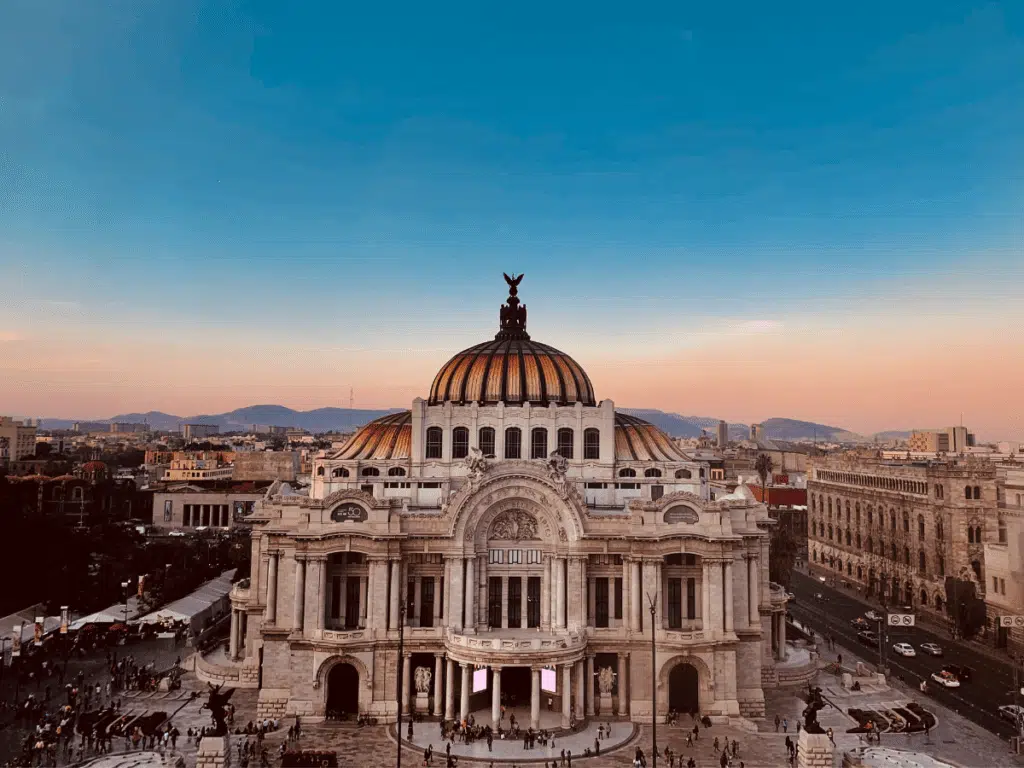
4. Mexico City, Mexico
While Mexico City may be one of the world’s largest cities, it is also one of the world’s greatest for its incredible culture, food, people, and the endless opportunities the city offers.
As one of Latin America’s most thriving digital nomad hubs, there are plenty of opportunities to grow professionally while experiencing all that Mexico City has to offer. As a major international city, the internet is great, too, and its proximity to the United States and Canada can be helpful for digital nomads with connections there.
Oh, and did we mention the travel potential from being based in Mexico City? It allows you easy access to the beaches on either coast of the country, as well as the countless picturesque cities in the interior of the country like Guanajuato, Puebla, and San Miguel de Allende. You’ll also enjoy the rich history of Mexico, including exploring Aztec ruins, colonial churches, and much more.
Pros of Mexico City, Mexico
- Mexico City is one of Latin America’s largest digital nomad and expat community hubs, representing all industries – you’ll have plenty of opportunities for networking and making friends here.
- It can be quite inexpensive to set up in Mexico City when seeking out low-cost and local food options and rentals outside of the trendiest neighborhoods.
- When it comes to amenities, Mexico City has everything you could ever want and more – cafes, restaurants, coworking, an international airport, and plenty of things to see and do, including tons of cultural highlights.
- The food in Mexico City is unrivaled. Live here just to eat your way through the city; it’s worth it.
- The travel potential from Mexico City is incredible. Spend time bouncing to different digital nomad hubs on the coast, like Puerto Vallarta, or in the center of the country.
Cons of Mexico City, Mexico
- Mexico City is massive, and at times can be hard to navigate. Though public transportation is plentiful and not expensive, traveling from one end of the city to another can feel like visiting a different part of Mexico.
- Costs of living in Mexico City can quickly ride if you don’t keep a budget and if you prefer to stick towards trendier parts of the city or eat out a lot at anywhere other than local spots. Keep a budget to keep costs down.
- The air pollution in Mexico City is notoriously bad, and city crowds can be overwhelming for those not used to living in a city.
Cost of Living: $1000-2000 per month
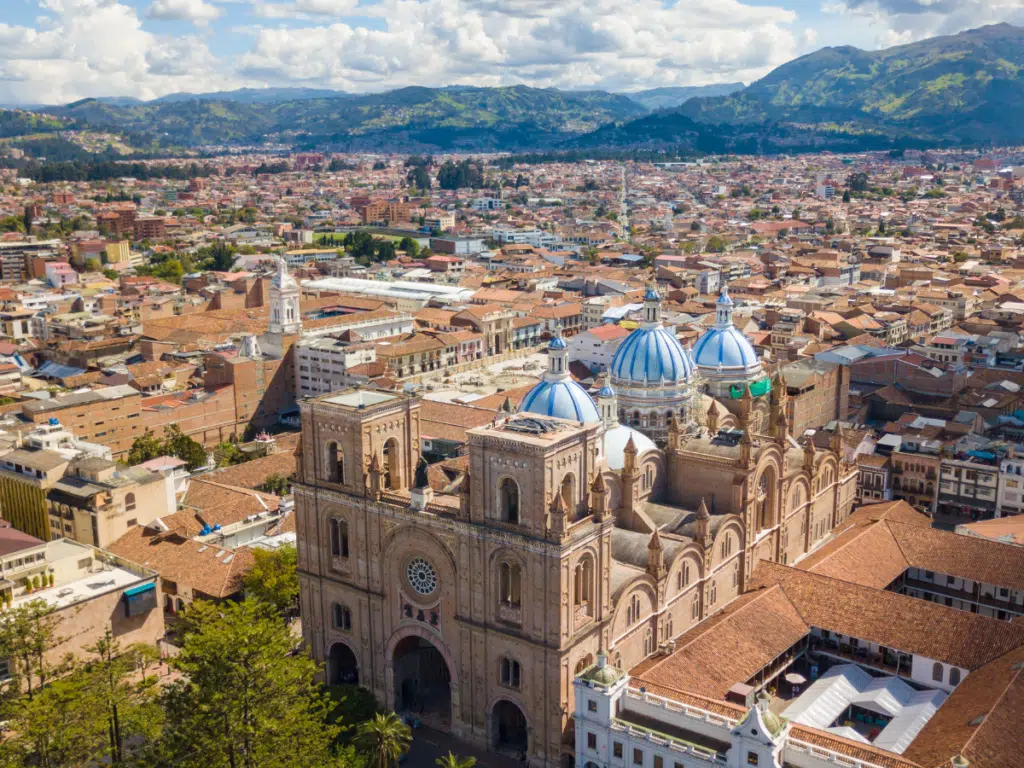
5. Cuenca, Ecuador
The Andes Mountains are home to Cuenca, Ecuador, another colonial gem smaller and slower-paced than Quito. Cuenca is known in Ecuador and around the world to be a hub for expats and retirees that choose the city for its affordable and plentiful amenities and perfect year-round weather.
Cuenca is a beautiful city with an incredible colonial center it’s hard not to fall in love with. Digital nomads will love the coworking space ImpaQto (also our favorite from Quito!), and the Selina Cuenca spot is impressive.
While Cuenca is a bit more expensive than Quito due to the larger number of foreigners, it offers a lot for those looking to set up base as digital nomads, including good internet speed, fun activities and plentiful nearby travel opportunities, and plenty of expats and digital nomads from all around the world to mix with.
Read More: Cuenca, Ecuador: Ultimate Traveler’s Guide
Pros of Cuenca, Ecuador
- Cuenca is much more laid-back than Quito. Expect less traffic and less hustle and bustle, making it a popular option for travelers who aren’t as used to living in bigger cities.
- Cuenca is gorgeous, with a stunning colonial center, beautiful landscape, and endless nearby day trip potential. You’ll love living in such a beautiful spot.
- The number of expats and long-term travelers in Cuenca will make you feel at home. While Cuenca isn’t as much of a “digital nomad hub” as Quito, you’ll find plenty of friends from home here.
Cons of Cuenca, Ecuador
- While the number of expats and foreigners in Cuenca can have its benefits, it also has its downsides. Cuenca is more expensive because of this, and if you’re trying to push yourself to make local friends, you might have a harder time doing so.
- In Cuenca, you lack some of the conveniences of Quito. There is no international airport here, so you’ll have to fly or drive to Guayaquil to catch an international flight. While you’ll have no trouble shopping or finding places to eat, you won’t find as many options or as much variety as in Quito
Cost of Living: $1,400-2,200 per month

6. Oaxaca, Mexico
While Mexico City is Mexico’s digital nomad hub, there are a variety of smaller cities that are attracting digital nomads these days as well. Whether you’re interested in just passing through these cities or basing yourself here for the long term, they have much to offer for remote workers.
For a more laid-back digital nomad experience than Mexico City, consider Oaxaca, Mexico! This central Mexican city is vibrant and colorful, has incredible food, and is much more affordable than Mexico City while still having all the amenities you could need. It’s surprising that given all this city has to offer it isn’t more jam-packed with expats and digital nomads – at least not yet.
One of the best reasons to choose Oaxaca over Mexico City is the affordability of Oaxaca. Long a favorite spot with backpackers in Mexico, the city offers a lot to attract digital nomads as well: strong internet, plenty of things to see and do, and excellent travel potential! Apartments can be quite affordable in Oaxaca as well.
Pros of Oaxaca, Mexico
- The state of Oaxaca boasts incredible beach towns, stunning historic villages, and more. You’ll absolutely love the travel potential from Oaxaca, and find you have more on your Oaxaca bucket list than you could have expected.
- Oaxaca has much more affordable prices than Mexico City while boasting just as good (or better!) local eats, plenty to see and do, and even nicer weather.
- While Oaxaca doesn’t have every abundant convenience of Mexico City, it’s hard to think of something you can’t find here. There’s even a Walmart, for gosh sake.
Cons of Oaxaca, Mexico
- You won’t find as many digital nomads in Oaxaca as you will in Mexico City, though the community feel is strong if you search out your tribe. For many remote workers, it can actually be much easier to manage than Mexico City’s bursting-at-the-seems digital nomad groups.
- If you crave unending activities and vibrant nightlife, you’ll run through Oaxaca’s scene in just a few weeks and be ready to move on. While Oaxaca is a city, it isn’t a BIG city, meaning that if you’re looking for big-city living, just plan on a short stay here.
Cost of Living: $1,200-2000

7. Antigua, Guatemala
Antigua, Guatemala might not be the major hub for digital nomads like Mexico City or Medellin, but it is an up-and-coming digital nomad hotspot in a much more relaxed and smaller city than some of the others on this list.
Antigua is the beautiful colonial center of Guatemala and provides a gorgeous backdrop for work and travel. It is an absolute must on any Guatemala itinerary, but even as a digital nomad you’ll love sticking around.
While Antigua doesn’t have as many major amenities as neighboring Guatemala City, it has plenty to keep you busy. Antigua has cultural events, cafes and bars, activities, treks, and day trips galore. There is also good availability of workspaces in the city such as cafes and coworking spaces – check out Impact Hub – if you’re not interested in working from home all the time.
Read More: Antigua, Guatemala: Ultimate Travel Guide
Pros of Antigua, Guatemala
- Antigua is a smaller city, so if you’re not a typical big-city person, you won’t feel so confined and have more space to spend time outdoors exploring.
- As an up-and-coming digital nomad hub, Antigua is very affordable and has plenty of activities and nearby travel destinations. Of course, prices in the city are higher than what you’ll find in the countryside, but still extremely reasonable.
Cons of Antigua, Guatemala
- The internet speed in Antigua can be moderate or decent but isn’t blazing fast. Make sure to check out and test internet speeds before deciding on a place to stay or cafe to work from for the day.
- Antigua doesn’t have as many amenities as you’d find in a large city, though you are close to the capital, and transportation is quite easy. Keep this in mind before settling down for a longer stay.
- As one of the major tourist hubs in Guatemala, there are a lot of things targeted toward foreign visitors. This can be a plus – you’ll be able to find things from home you crave! – but it also means that your cost of living can rise quickly if you’re not careful.
Cost of Living: $800-1,600 per month
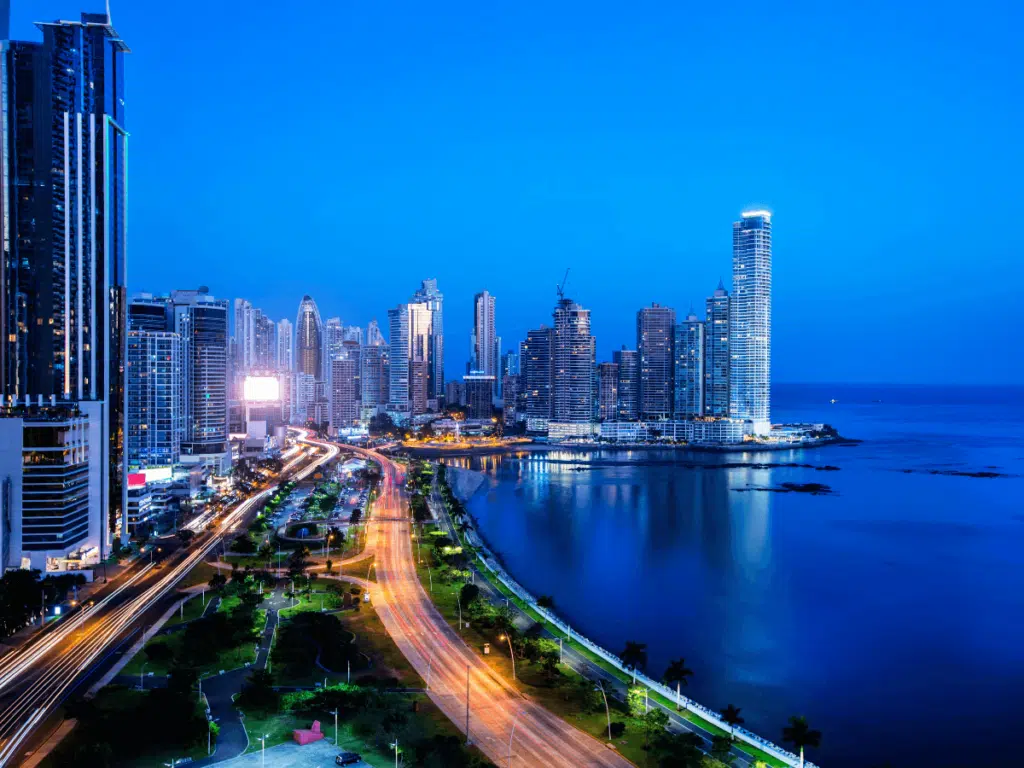
8. Panama City, Panama
While Panama City, Panama might not be the biggest tourist hotspot in Latin America, it can make a great destinations for digital nomads. This modern, vibrant city is well-connected to the rest of North and South America, offers every convenience you can imagine, and is well-positioned for exploring both Central America and the Caribbean.
With excellent internet, plenty of things to do, and a wide range of accommodation options and coworking spaces, Panama City is built for digital nomads. It’s actually surprising that more digital nomads don’t call it home. A perfect gateway for heading to the lush rainforest and pristine beaches, Panama City is a traveler’s dream – make sure to book your visit before prices rise, as they have been for decades in neighboring Costa Rica.
Another plus? Panama’s new digital nomad visa makes it easier than ever for remote workers to settle down for a while without having to continually renew visas or make “visa runs” as you might in other destinations. While this visa isn’t for everyone, it’s a great option and demonstrates Panama’s commitment to attracting remote workers.
Pros of Panama City, Panama
- You’ll want for nothing in Panama City. Endless opportunities for shopping, activities, cultural events, and nightlife pack the city – no matter what you’re looking for, you’ll find it here.
- Panama City is a great place to grow your business. Long a business and finance capital in the region, Panama City has stellar internet, a strong business community, opportunities for networking, and much more.
- Panama is quite welcoming to foreigners, as you’ll find with its digital nomad visa, and the general warmth you’ll feel from locals.
Cons of Panama City, Panama
- Panama City can be more expensive than other cities in Latin America, and certainly more expensive than other destinations in Central America. If you’re on a tight budget, it might not be for you.
- If you’re a bucket-list traveler seeking out the most popular destinations and attractions, Panama might not be as attractive as neighboring Colombia or Costa Rica, which tend to steal a bit of Panama’s shine. However, if you’re looking for off-the-beaten-path experiences and uncrowded spots, Panama will be a dream.
Cost of Living: $1,500-2,300
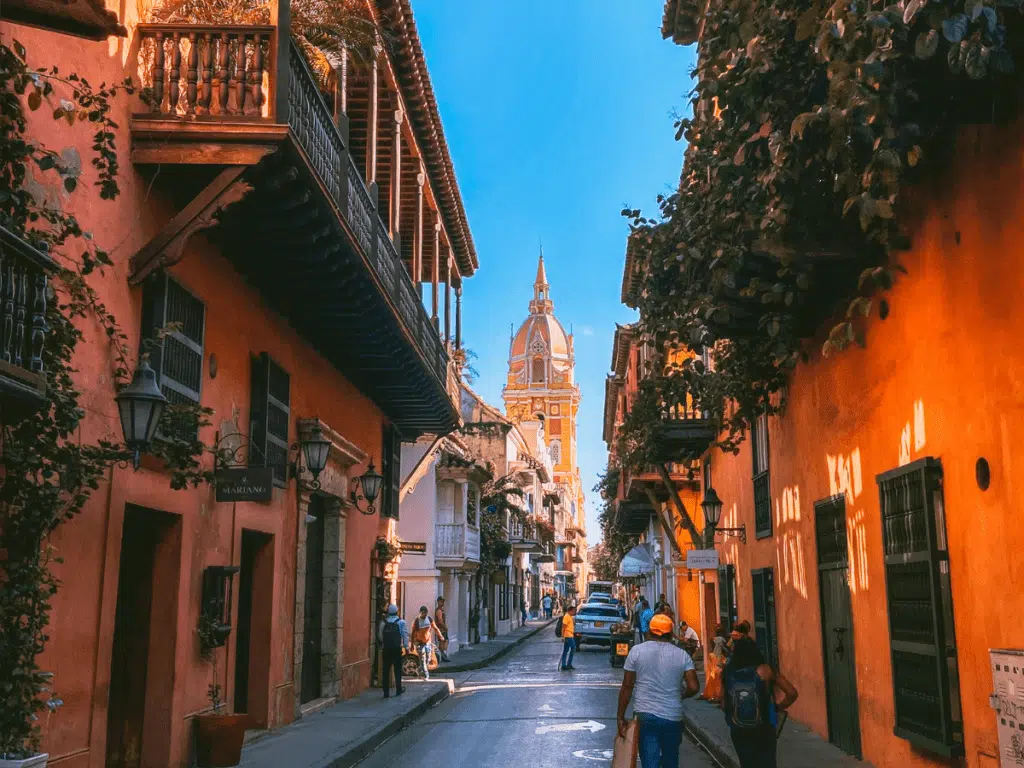
9. Cartagena, Colombia
Surprised to find Cartagena, Colombia made the list? While Medellin is certainly Colombia’s capital for digital nomads, with one of the most thriving digital nomad communities in Latin America, Cartagena has increasingly more remote workers visiting the city, whether it’s just for a week or two or for a whole season.
This historic Caribbean port city with great beaches, soaring skyscrapers, and an unending list of activities and attractions is an obvious choice for travelers looking for a warm-weather escape. Just a short flight from Miami, it’s a great choice for travelers that need to stay close to home or travel for work. It’s also the best gateway to exploring Colombia’s coast.
Though Cartagena can get touristy, if you can look past these sections (and afford to stay in Colombia’s most vibrant, expensive city!) you will absolutely love the experience of living in Cartagena.
Read More: Cartagena, Colombia: Digital Nomad Guide
Pros of Cartagena, Colombia
- Cartagena is vibrant! With plenty of historic charm, cool new cafes and restaurants, tons of travelers, and endless things to do in Cartagena, it’s impossible not to fall in love with all Cartagena has to offer.
- If you’re looking to experience Colombia’s beaches rather than the Andes Mountains of Bogotá or Medellin, Cartagena is the place for it. The nearby Rosario Islands are some of the most affordable and best islands in the Caribbean, Isla Barú‘s Playa Blanca is among the nicest beaches in Colombia, and endless beach excursions are at your fingertips here.
- Cartagena has every convenience you could ask for as a digital nomad: fast internet, an international airport, and so much to see and do.
Cons of Cartagena, Colombia
- As a cruise port and one of the most popular cities in Colombia for travelers, Cartagena can get quite busy, with the historic areas of the walled city feeling touristy and even overrun during peak travel season. For a more authentic, less packed Cartagena, stay further outside the city or plan your visit during the off-season.
- Cartagena is quite a bit more expensive than other Colombian cities, especially if you’re looking to stay in the city’s nicest neighborhoods. Apartments can be budget-blowing and double what they’d cost in other areas of Colombia.
Cost of Living: $1,500-3,000

10. La Paz, Bolivia
If you’ve read any number of my articles, you’ll know I am a big champion of Bolivia as being an incredible off-the-beaten-path destination, one of my picks for the most underrated yet truly spectacular places to travel. If you’re looking for a unique digital nomad destination, consider heading to Bolivia’s capital of La Paz.
Though La Paz is not a digital nomad hub, there are tons of things to do in La Paz that will make you fall in love with it. Absolutely breathtaking mountain scenery, and incredible mix of indigenous and mestizo cultures, ultra-affordable prices from everything from accommodations and food to travel, and tons to see and do all make this city a fabulous if often-overlooked choice.
Read More: La Paz, Bolivia: Ultimate Travel Guide
Pros of La Paz, Bolivia
- La Paz can be quite cheap! This is one of the major draws for digital nomads. You can live quite comfortably, even with a touch of luxury, for under $1,000 a month. If you budget carefully and choose to live outside of the trendiest areas, you can spend a fair amount less than $1,000 per month.
- If you want to connect with locals and get off the beaten path, La Paz is a great choice. The expat / remote worker community is small, but you’ll be welcomed right in to this close-knit network.
Cons of La Paz, Bolivia
- Though Bolivia is actually one of the safer countries in South America, be aware of pickpocketing in La Paz, and use street smarts to avoid it. Don’t flash expensive jewelry or technology, and be aware of your surroundings when out and about
- Internet in La Paz can sometimes be hit or miss, with speeds being a bit slower than you’re used to. Make sure to test internet speeds before committing to a cafe or coworking space to work at or a place to stay.
- You simply won’t find as many digital nomads in La Paz as you will in neighboring capital cities. Some find this a huge bonus, though others will miss the lack of a digital nomad “hub” feeling.
- La Paz is quite isolated from other major cities. Though it has a well-served international airport, bus travel can be prohibitively long to other capitals or even just large cities.
Cost of Living: $700 – 1,200
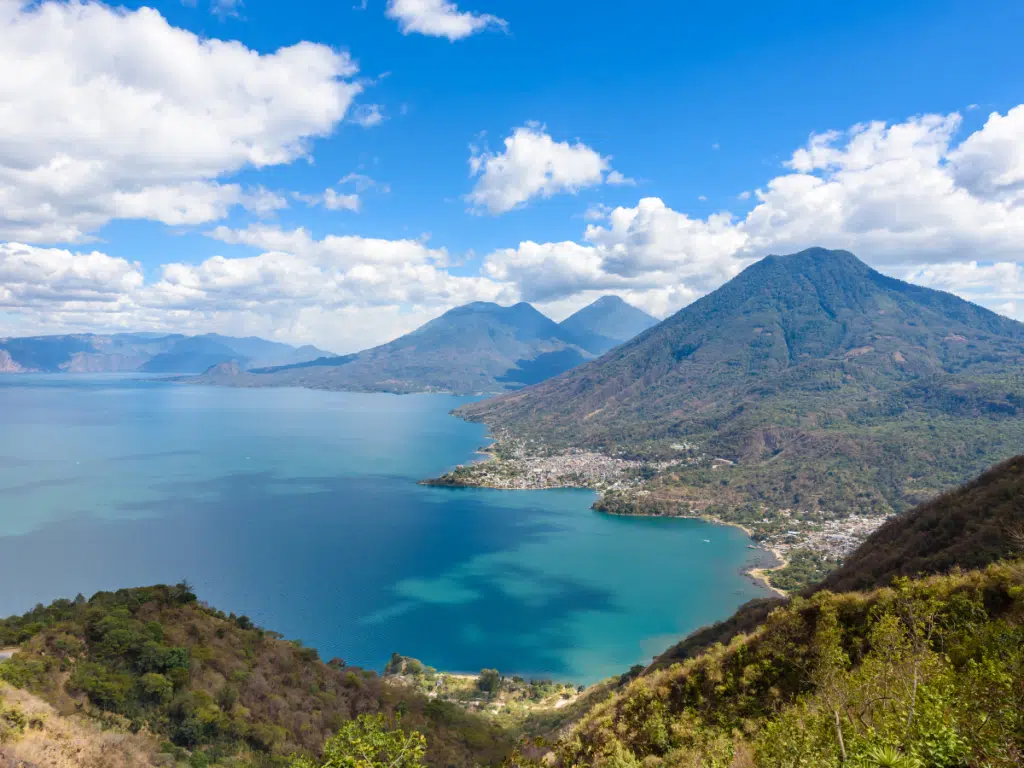
11. Lake Atitlan, Guatemala
Not exactly one specific city, but a cluster of several make up one of the most up-and-coming destinations for digital nomads in Latin America. Lake Atitlan is a stunning lake surrounded by volcanoes in the highlands of Guatemala, perfect for digital nomads looking for laid-back, uncrowded spots with gorgeous scenery.
In fact, this is one of the most popular places to visit in Central America, though it still remains relatively uncrowded and off the beaten path. Small towns like San Pedro, San Marcos, and Panajachel surrounding the lake are all very different and make for some great places to explore.
Most digital nomads settled in San Pedro, which has a backpacker community and vibe, or Panajachel. With its Selina Atitlan location, it’s adding spots for digital nomads and remote workers fast!
It is important to note that internet speed is generally moderate at best, and with smaller towns around the lake, there are fewer city amenities than you may be used to in larger digital nomad hubs. Don’t expect big city living here! It’s all about small-town living and community feeling. Worried you’ll go stir-crazy? With Antigua just over two hours away, you’re close enough to enjoy this larger city, too.
However, if you’re looking for a smaller and more tranquil area to spend time as a digital nomad, and at a much lower cost, Lake Atitlan may be the perfect place to try.
Pros of Lake Atitlan, Guatemala
- Volcano hikes, countryside excursions, and indigenous highland towns in the area galore, meaning you’ll have plenty to keep you busy if you’re looking to explore.
- The towns surrounding Lake Atitlan are so cool, and quite unique even from each other. Some have more hippie, laid-back vibes, some are more traditionally Guatemalan and lack a lot of outside influence, and some are backpacker hotspots. Before choosing where to stay, explore them all!
Cons of Lake Atitlan, Guatemala
- While it continues to improve, internet speeds can be spotty, even in more populated parts of the lake towns. Choose a coworking space or cafe in a busier area of town, and don’t venture too far off the beaten path if you need to get work done.
- You won’t find as many true digital nomads in Lake Atitlan as you will in larger Latin American and South American cities. Backpackers and long-term travelers are more common, so if you’re looking for a true remote work scene, this might not be a destination for a long stay.
- You’ll find plenty of cute cafes, little shops, and places to stay, but not much in the way of big city amenities around the lake. Head to Antigua as needed.
Cost of Living: $700-1,400
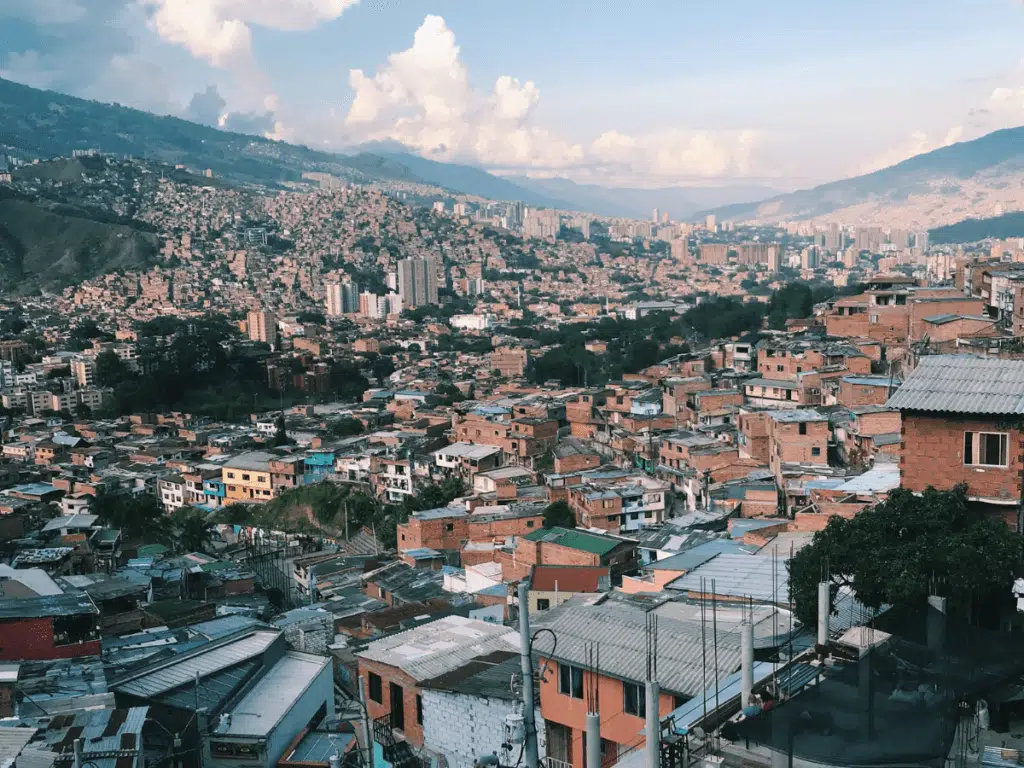
12. Medellin, Colombia
Medellin is a city that has been totally transformed in the past few decades, and is now considered one of the major hubs for digital nomads in Latin America. A few years ago, I spent two months living in Medellin, so I can attest to it being an incredible place to spend time – I feel like I just scratched the surface of all there is to do there.
Part of what makes Medellin so attractive for so many digital nomads is its combination of the things you’ll need to work online, like a strong internet connection and plenty of coworking spaces – check out Selina or Semilla Cafe Coworking – and cafes as well as things to do outside of work.
The big city amenities you can find here are also quite affordable for a major city, setting it apart for nomads.
Medellin is also perfectly located in the center of Colombia to reach the beach for a weekend trip (don’t miss Cartagena, Colombia!), the capital of Bogotá, and nearby the majority of the country’s coffee plantations, all making for some incredible trips.
Pros of Medellin, Colombia
- Medellin has fast internet speeds, and internet is widely available, plus the number of coworking spaces will blow your mind. This is truly a city set up for remote work and digital nomad life.
- As a true hub of digital nomads in Latin America, there are endless opportunities to meet other travelers and expats, whether you’re interested in finding travel buddies, future coworkers, or just great friends.
- While the cost of living in Medellin is getting a bit higher, it’s still quite affordable to live here, especially if you ditch the trendiest neighborhoods for more residential ones. The low cost of living and the accessibility of amenities make the city ideal.
Cons of Medellin, Colombia
- While safety in Medellin has come a long way, some areas of the city can be unsafe. Regardless of your area, take care when walking outside at night. Check out our ultimate guide to where to stay in Medellin for more information about safe neighborhoods
- Having so many amenities at your fingertips also means that costs can build up quickly if you live in a nicer area and only frequent spaces targeted towards foreigners rather than locals. Make sure you eat at local spots rather than at international ones – this can be a budget-buster!
Cost of Living: $650-1,600 per month

13. San José, Costa Rica
Costa Rica is known for being a Latin American country that has long attracted expats and retirees from around the world for its beautiful beaches, pleasant weather, and tranquility. There are so many things to do in Costa Rica and places to explore that you could easily spend weeks or months here without getting bored. But what is it like for a digital nomad? It depends what lifestyle you’re looking for!
There are many smaller towns in Costa Rica that also are home to long-term travelers or transplants from countries around the world, making pinning down a singular hub for digital nomads in Costa Rica challenging. However, as the capital of Costa Rica, San Jose offers the greatest array of amenities that make it easy to adjust to digital nomad life.
For those looking for small-town digital nomad hubs, check out the beach towns of Tamarindo, Santa Teresa, and Puerto Viejo. While San Jose is not as picturesque as many other cities on this list, it offers many attractions, restaurants, cafes, and coworking places – Selina San Jose is a great option! – to make it stand out.
It is also conveniently centrally located for other travel, including countless options for day trips and weekend trips! You’ll find countless beautiful beaches in Costa Rica within easy distance for an overnight or weekend trip.
Pros of San José, Costa Rica
- Proximity to the beach and jungle from San José is attractive and provides a high quality of life for remote workers looking to settle down here for awhile. The day trips from San José – and long weekend excursions – are second to none.
- San José has tons of amenities you’d expect in a major city, but at a more relaxed pace than larger cities on this list. It’s a great balance between convenience and congestion. Though it lacks some of the charms of nearby capitals, it has everything you could ever want.
Cons of San José, Costa Rica
- The cost of living in Costa Rica can be relatively high, especially in comparison to other countries in Latin America. While this is particularly true in popular beach towns, San José is no exception.
- Many foreigners prefer the smaller towns in Costa Rica that are closer to the ocean or jungle, though it can be harder to find concentrated expat or digital nomad communities there.
Cost of Living: $1100-1700 per month

14. Tulum, Mexico
Though Mexico City is the digital nomad darling of Mexico, the beach towns of the Yucatán like Playa del Carmen and Tulum also have increasing digital nomad and expat populations and, of course, the incredible draw of the incredible beaches. Isn’t it the digital nomad’s dream to get some work done from a Tulum beach club, or fish taco shack by the sand?
Now thoroughly a digital nomad hub in its own right, Tulum is seeing record numbers of remote workers and long-term travelers packing this once-small beach town. It’s a trend that hasn’t gone unnoticed (Nomadic Matt famously hates Tulum), some digital nomads even turning their noses up at what some consider to be a town overtaken by foreigners.
While Tulum is busy, it’s a great choice if you’re looking for that vibrant remote work community and the beachfront living Tulum is so known for. You’ll easily meet other travelers and digital nomads and can fall into great friendships or even working relationships with ease.
Tulum can get a bad rap for being a party destination or just for young travelers, but I know plenty of digital nomads with families, or even those who just aren’t interested in the party scene, who have enjoyed their time here, too. If you know where to look, you’ll find plenty of family-friendly Tulum options for accommodations, eating out, and activities.
Pros of Tulum, Mexico
- You will find your fellow digital nomads in no time in Tulum!
- Beach living in Tulum is so dreamy. While actual beachfront accommodations can be quite pricy, exploring small-town streets, spending afternoons on the beach after work, and enjoying the warm Caribbean weather is a major draw to this corner of Mexico.
- Cute cafes and restaurants, international food that reminds you of home, great nightlife, and spots for coworking galore in Tulum. Coliving and month-to-month apartment rental are additional benefits that make setting up in Tulum a breeze.
Cons of Tulum, Mexico
- Tulum, Mexico is now thoroughly a traveler / digital nomad town. Don’t expect to come here and find authentic and inexpensive Mexican food or make strong relationships with locals – while Tulum isn’t entirely devoid of these things, it’s so traveler-focused that it can be hard to find.
- Tulum is quite expensive. Expect to pay double or even triple what you’d expect to pay elsewhere in Mexico, even at other beach towns. Your money will go much further elsewhere.
- There are new concerns about safety in Tulum with more cartel activity in the area than before. While most travelers won’t ever encounter this, it is of concern to locals, and is something that can change quickly.
Cost of Living: $1,500 – 3,500

Carley Rojas Avila is a bilingual New York-based travel writer, editor, content marketer, and the founder of the digital travel publications Explorers Away and Home to Havana. Carley is an expert on all things Latin America, the Caribbean, and Cuba, having lived and worked in four different countries in the region. Her writing has appeared on the Associated Press wires and in Travel + Leisure, Yahoo, MSN, Euronews, The Weather Channel, and more. When she's not writing about her travels, find her front row at a Bad Bunny concert, befriending street cats, and taste-testing every pizza in Havana.

